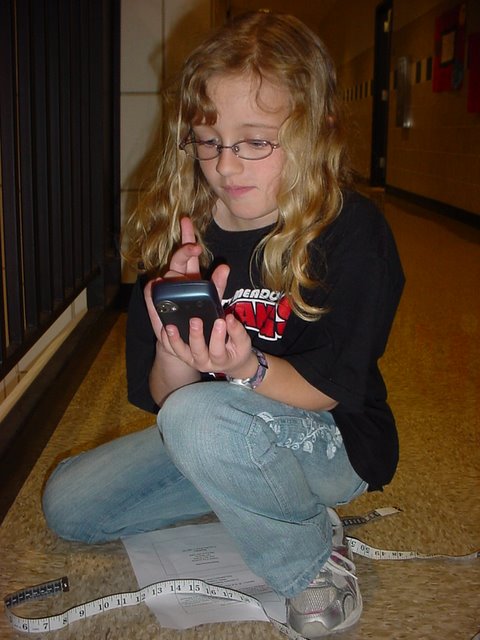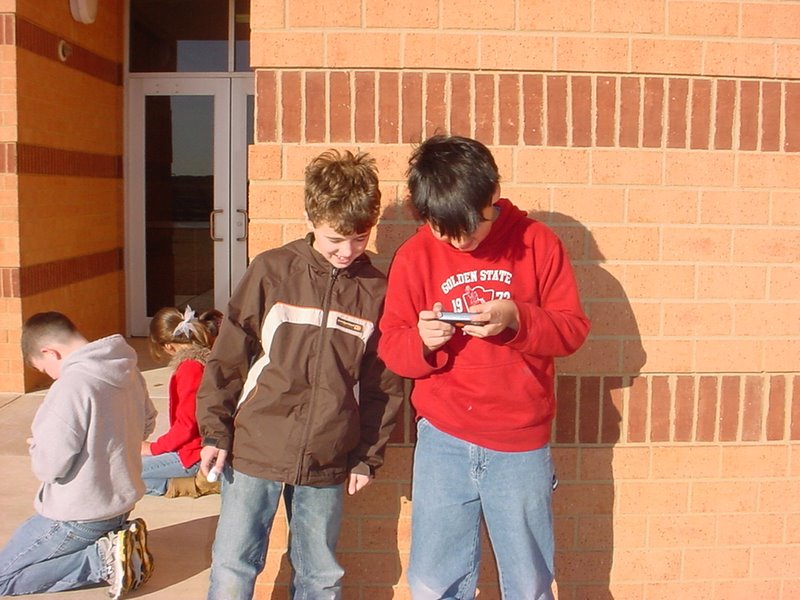Mobile TechnologyGoes to School
Visit Matt Cook's classroom at Trinity Meadows Intermediate School in Keller, Texas, and you are likely to find students who are glued to their cell phones -- and their teacher couldn't be more pleased.
It is all part of a project initiated byCook and supported by corporate sponsors. The fifth grade teacher and his students are exploring the educational uses of cell phones, which Cook believes in the long run will become the cheapest way to do one-to-one computing. The portability and mobility of cell phones make them an ideal teaching tool, toting the classroom anywhere, anytime.
"The kids take the phones 24-7, and have completed many different assignments from home," Cook told Education World. "I also get e-mail messages from them after school asking questions about assignments."
The project began as the glimmer of an idea in the summer of 2007. Cook recognized that many of his students had cell phones, which they carried with them throughout the day. At a time when some educators sought ways to eliminate cell phones as a distraction, Cook wondered how he might capitalize on the technology that students already possessed.
A CELL PHONE IN EVERY POCKET
Cook encouraged students to use their cell phones to document their work and findings during science labs. He asked them to send photos to him afterward. Students enjoyed using the phones in that way, but there were problems. Cook hadn't yet found the best practices or uses for the cell phones, and he hadn't considered the possibilities of texting or Bluetooth. He knew, however, that cell phones were a powerful teaching tool waiting to be tapped.
"In the summer of 2008, I went to a conference in San Antonio and attended every cell-phone-related session I could find," recalled Cook. "I was thrilled and inspired with a greater understanding of the potential use of the technology in schools. I had a chance to talk in depth with experts, and the discussions ignited a plan."
Cook's plan was to form a partnership with a company that would fund a pilot program in his classroom. Every student would receive a cell phone for educational use; Cook would find new and innovative ways to use the new classroom tools with his students; and the company would have a proven and viable new market for its products.
"I sent off an e-mail to Verizon Wireless to see if the company had any interest in the project," Cook explained. "Verizon called me back in a few days, after the message had bounced around to different people. When I explained the project, they became excited and wanted to learn all they could about the subject. Fresh off the conference, I had many resources at my disposal and quickly made those available for them to view."
A powerful alliance was formed for Cook's program. Verizon provides the service; HTC donates the cell phones; and Microsoft Mobile is helping with software issues. Elliot Solloway and Cathleen Norris have developed the software called GoKnow, which is the primary software used by Cook and his students. Cook also receives continual support from principal Ron Myers, the Keller Independent School District board, Superintendent James Veitenheimer, as well as the entire district technology team.
Now, Cook's fifth graders use their cell phones on a daily basis to collaborate by sharing information; to gather data; and to work with Microsoft Word and Excel. They can review material with PowerPoint, communicate about projects, and capture images of their work with the cell phone cameras. GoKnow provides applications that students use every day, such as Sketchy, an animation/drawing tool, and MyProjects, which enables students to access a project home page and organize multiple resources.
"As a teacher, I use GoManage to push out applications and files to the phones as the kids wireless sync," explained Cook. "We also use Gaggle for e-mail communications with the kids. It is safe and filtered."
The phones are not voice or text enabled, but Cook's students are encouraged to explore other ways to use the phones to enhance their learning.
PARENTS IN THE "CIRCLE"
"Parents have been very supportive, in part because we worked as hard as possible to keep them informed," says Len Avecilla, a Trinity Meadows parent. "In fact, from long before the kids held the devices in their hands, we tried to create awareness, establish knowledge of the outcomes of importance, and involve parents in virtually every phase, from inception to post deployment.

As a member of the district technology committee, Avecilla has been instrumental in keeping parents aware of the progress of the program. Regular workshops for parents have been held, including a recent mid-term update in March. Parents have expressed their chief concern that the cell phone activity must be used to enhance and not detract from the mastery of traditional content.
"Our original plan was to pilot two more extensions -- one to sixth grade, and one 'across the way' in the middle school. Those are crucial extensions, but we're still waiting on another supply of phones in order to deploy those two phases of the project," shared Avecilla.
So Avecilla's sixth grade son, who attends Trinity Meadows Intermediate School, must wait to take advantage of the benefits of cell phones in instruction.
"My child is involved nevertheless, in a documentation project," Avecilla added. "He and several other sixth graders are producing three separate documentary videos about the fifth grade pilot project.







No comments: